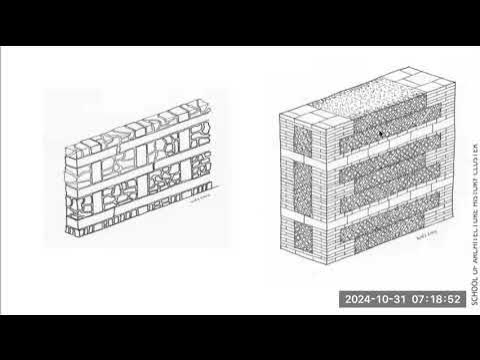Gothic Architecture Style Characteristics & History
Summary
TLDRThis video explores the revolutionary shift in architecture initiated by Abbot Suger in the 12th century with the construction of the Church of Saint-Denis. His vision of a church filled with light and soaring toward the heavens led to the development of Gothic architecture. The video highlights three key innovations—pointed arches, ribbed vaulting, and flying buttresses—that allowed for taller, more stable, and more luminous buildings. These features not only distinguished Gothic architecture from Romanesque structures but also marked a significant advancement in medieval engineering, influencing the design of cathedrals across Europe.
Takeaways
- 😀 Abbot Suger began rebuilding the Abbey Church of Saint-Denis in 1137, seeking a more graceful and luminous church design.
- 😀 Gothic architecture, a term coined by critics, was an innovative departure from Romanesque styles, which were darker and bulkier.
- 😀 The three main architectural features of Gothic cathedrals are the pointed arch, ribbed vault, and flying buttress.
- 😀 The pointed arch redirected the weight of the roof downwards, replacing the horizontal stress lines of Romanesque arches.
- 😀 Ribbed vaulting used a network of ribs to support the weight of the ceiling, allowing for lighter materials in the walls.
- 😀 The flying buttress was introduced to support the outward pressure of the roof by redirecting force to external piers.
- 😀 Gothic cathedrals had thinner walls with large windows, which allowed for the inclusion of beautiful stained-glass windows.
- 😀 The innovations of Gothic architecture allowed for much taller, more graceful cathedrals compared to Romanesque predecessors.
- 😀 Despite being labeled 'Gothic' due to its perceived barbarity, Gothic architecture represented an advanced achievement in engineering and art.
- 😀 The birth of the flying buttress allowed the vertical soaring height of Gothic structures without compromising structural integrity.
Q & A
Who initiated the rebuild of the Abbey Church of Saint-Denis, and why was it significant?
-Abbot Suger began the rebuild of the Abbey Church of Saint-Denis in 1137. His goal was to replace the dark, bulky Romanesque style with a more graceful and harmonious design, expressing the divine through geometry and light. This marked the beginning of Gothic architecture.
What are the three key elements of Gothic architecture?
-The three key elements of Gothic architecture are the pointed arch, ribbed vault, and flying buttress. These elements revolutionized the design of cathedrals and allowed for taller, more luminous buildings.
How did Gothic architecture differ from Romanesque architecture?
-Gothic architecture was more vertical, elegant, and light-filled compared to the short, thick, and dark Romanesque style. The use of pointed arches, ribbed vaulting, and flying buttresses allowed for higher ceilings and larger windows in Gothic structures.
Why was the pointed arch so important in Gothic architecture?
-The pointed arch redirected the weight of the structure downward rather than outward, which allowed for thinner walls and larger windows. This made it possible to create taller buildings with less bulk.
What role did ribbed vaulting play in Gothic cathedrals?
-Ribbed vaulting used a framework of ribs to support the ceiling, allowing for thinner walls and a more flexible design. It concentrated the weight in specific areas, reducing the need for massive walls.
What challenge did Gothic architects face with ribbed vaulting, and how was it addressed?
-The ribbed vaulting redirected weight downward but still exerted outward pressure on the walls. Gothic architects solved this by using flying buttresses to redirect this force to the ground, allowing for thinner walls and larger windows.
What is the function of flying buttresses in Gothic cathedrals?
-Flying buttresses were external supports that helped redirect the outward pressure of the vaulted ceiling to the ground. This allowed for thinner walls and large, luminous stained-glass windows.
Why did critics initially call the new architectural style 'Gothic'?
-The term 'Gothic' was used by critics in the 12th century to describe Suger's new architectural style, referencing the Goths, who were seen as barbaric. The term was originally meant as an insult, but the style eventually became recognized for its innovation.
How did the use of stained-glass windows impact Gothic cathedrals?
-Stained-glass windows became a defining feature of Gothic cathedrals. They filled the interiors with vibrant light, contributing to the spiritual and ethereal atmosphere of these churches, thanks to the thinner walls made possible by the architectural innovations.
What was the significance of Gothic architecture in the context of medieval Europe?
-Gothic architecture marked the apex of medieval engineering and artistic achievement. It represented a departure from the influence of Roman architecture, with its innovative features such as pointed arches, ribbed vaults, and flying buttresses, contributing to the development of European cathedral design.
Outlines

This section is available to paid users only. Please upgrade to access this part.
Upgrade NowMindmap

This section is available to paid users only. Please upgrade to access this part.
Upgrade NowKeywords

This section is available to paid users only. Please upgrade to access this part.
Upgrade NowHighlights

This section is available to paid users only. Please upgrade to access this part.
Upgrade NowTranscripts

This section is available to paid users only. Please upgrade to access this part.
Upgrade Now5.0 / 5 (0 votes)





